

Identifying Appendicitis
Incidence – In the USA, appendicitis affects 1 in 1,000 people. Most cases of appendicitis occur in people between the ages of 10 and 30 years.
Etiology – Appendicitis may be caused by viral or bacterial infections as well as parasites in the digestive tract. Appendicitis can also occur when the tube that connects the appendix to the large intestine is blocked.
Warning signs – The first sign that might be experienced is pain around the belly button. As often happens with visceral pain, it may start off generalized and dull. As the magnitude of the infection/blockage increases, the pain will become more localized in the lower right abdomen and becomes sharp.
Symptoms –
- Low-grade fever (below 100 degrees F)
- Nausea and vomiting
- Loss of appetite
- Right lower quadrant pain at McBurney’s Point (1/3 the distance from the right ASIS to the umbilicus)
- Rovsing’s Sign involves pressing on the left lower quadrant resulting in appendix pain – there are 2 schools of thought on this pathophysiology: 1.) Pushing the air in the colon produces appendix pain and 2.) Pushing the bowel to the right causes irritation of the appendix.
- Pain that worsens with cough, walk, or other jarring movements – if working with a child, ask the child to jump on a mini-tramp or bounce the child on a therapy ball.

 Clinical Tests – In addition to palpation, there are 2 clinical tests used to identify appendicitis: the Psoas Sign and the Obturator Sign. First, one must appreciate the relationship of the psoas and obturator muscles to the appendix. The psoas muscle is on the anterior aspect and the obturator muscle on the posterior aspect of the appendix. I guess one could say it creates an appendix sandwich!
Clinical Tests – In addition to palpation, there are 2 clinical tests used to identify appendicitis: the Psoas Sign and the Obturator Sign. First, one must appreciate the relationship of the psoas and obturator muscles to the appendix. The psoas muscle is on the anterior aspect and the obturator muscle on the posterior aspect of the appendix. I guess one could say it creates an appendix sandwich!

The Psoas Sign is performed in left sidelying. The right lower extremity is passively hyperextended and briefly held in the position to see if symptoms are reproduced (a positive test). Instead of placing the psoas on a stretch, some literature suggests incriminating the psoas via resisting hip flexion, i.e. contraction of the psoas. For passive hyperextension: Sensitivity = 16%, Specificity = 95%. Thus, the Psoas Sign is a strong diagnosis test.
 The Obturator Sign is performed in supine. The right lower extremity is flexed at both the hip and the knee to 90 degrees. Then the hip is passively internally rotated to place the obturator internus on stretch. When holding that position, a positive test is abdominal pain in the right lower quadrant.
The Obturator Sign is performed in supine. The right lower extremity is flexed at both the hip and the knee to 90 degrees. Then the hip is passively internally rotated to place the obturator internus on stretch. When holding that position, a positive test is abdominal pain in the right lower quadrant.
Two additional points to consider…..given the peak age of incidence being 10 to 30 years of age, a pregnancy test may be important to rule out an ectopic pregnancy. Finally, appendicitis can be chronic. Over a long-term, the condition is characterized by the symptoms coming and going. Because of the potential complications, it is important not to ignore the symptoms.
In summary, appendicitis is a diagnosis with numerous symptoms and several clinical tests to aid in the diagnosis but knowing the anatomy and the visceral referral pattern is paramount.
For more cutting-edge orthopedic information on iOrtho+ PREMIUM Mobile App, please visit https://iortho.xyz/
If you would like to learn more about the Mobil–Aider orthopedic arthrometer to quantify joint mobility, please visit: https://mobil-aider.com/
- Bates B. Guide to physical Examination, 6th ed. Lippincott, Phila. 1995
- Boissonnault WG. Primary care for the physical therapist. Elsevier Saunder. 2005
- Munro J, Campbell T (ed). Macleod clinical examination, 10th ed. Churchill Livingstone, Phila. 2000
- Navarro Fernandez JA, Tarraga Lopez PJ, Rodriguez Montes JA, et al. Validity of tests performed to diagnose acute abdominal pain in patients admitted at an emergency department. Revista espanola de enfermedades digestivas : organo oficial de la Sociedad Espanola de Patologia Digestiva 2009 Sep; 101
- Wagner JM, McKinney WP, Carpenter JL. Does this patient have appendicitis? 1996;276:1589-1594
